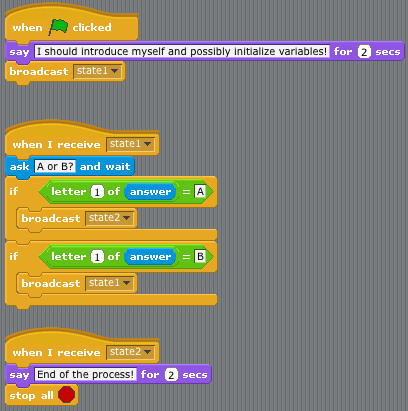https://sites.google.com/site/delawarecodingchallenge/home
12/7 Vocabulary Review for Diversity of Life. Hour of Code Start - https://hourofcode.com/code
12/8 Hour of Code and Jeopardy or Kahoot- https://kahoot.it/#/
12/9 Diversity of Life Final.- Scratch Car Game Start (see Below)
PART I http://tinyurl.com/ol6ky
PART II http://tinyurl.com/ohj8upa
12/10 Human Traits lab Period 2 & 1
12/11 Human Traits lab Period 4 & 3
Online Human Traits Lab
https://docs.google.com/forms/d/1sKUORjj6OQI-os2CtESWXeczamTe77m7rMHqe_hhj5s/viewform
Vocabulary
Big Ideas
Jeopardy
Only complete after you have successfully completed the hour of Code -
Scratch Car Game instructions- https://scratch.mit.edu/
An Adventure Game
https://scratch.mit.edu/


Here is an example of a game I made
https://scratch.mit.edu/projects/64263612/#player
https://scratch.mit.edu/
An Adventure Game
Many types of processes can be modeled as a set of states that are connected to other states. The process then "flows" from one state to another as the result of a decision. We can represent this in a flow-chart and in a Scratch program:
In this example the process starts with state1. Based on the user's choice of A or B, the process then flows to state2 OR back to state1 but not both. To make sure that our process reaches an end, we need to provide some states or conditions that eventually "stop".
For this exercise, begin by looking at the example adventure game, Chomp-Mini-Adventure.
Task #1
Draw a flow-chart diagram of the mini-adventure. You only need to include the states, the connections, and the decisions that cause the flow to change. For example, the conditions inside of the End state don't matter because the flow of the process does not change based on those conditions.
Task #2
Create your own adventure game about an animal. Before you start implementing it in Scratch, you should first list out some variables that you might want to keep track of, and then make a flow-chart of states and the decisions that affect the game flow.
- Your adventure character Sprite(s) must contain and show more than one costume.
- You must have at least three backgrounds.
- You must have at least one random block that affects your adventure.
- Your adventure must allow the user to make (at least) three decisions (questions). Each question can have two (or more) possible answers. Each answer should lead to some state with an associated script (it is okay if some combination of answers lead to the same state).
- Your adventure must have at least three different possible endings.
- Your adventure must use at least one variable that gets changed and used in different states.
- Your adventure must use one of the AND or OR blocks.
Here is an example of a game I made
https://scratch.mit.edu/projects/64263612/#player


No comments:
Post a Comment
Note: Only a member of this blog may post a comment.